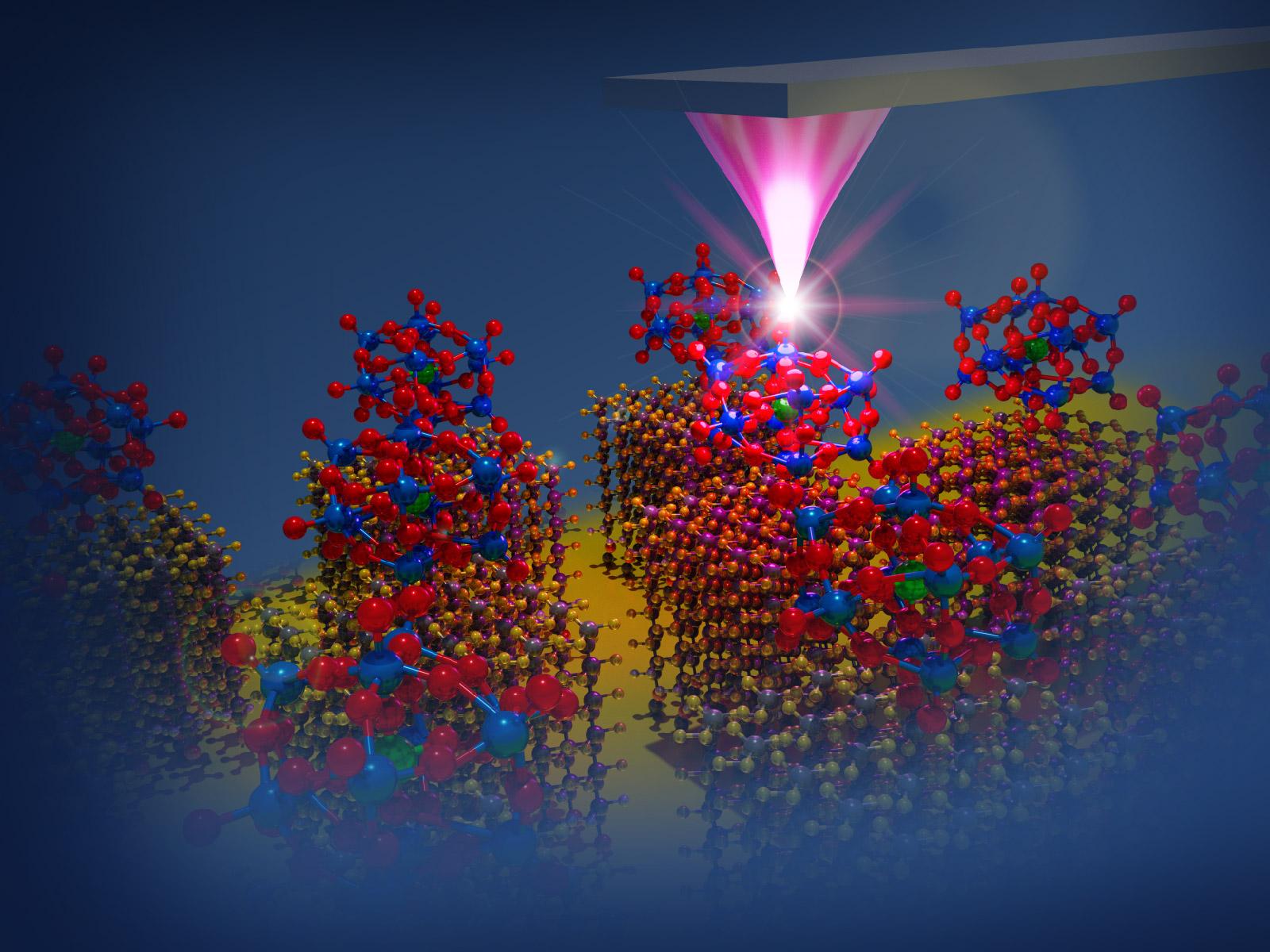Intermolecular and Support Interactions Influence the Properties of Polyoxometalates for Electrochemical Separations and Molecular Qubits
A combined experimental and theoretical study identified multiple interactions that affect the performance of redox-active metal oxides for potential electrochemical separation and quantum computing applications

Soft landing of mass-selected vanadium-doped polyoxometalates on surfaces without solvent, counterions, or contaminants allowed researchers to identify specific surface and intermolecular interactions that influence the properties of these species for potential applications in electrochemical separations and as molecular qubits.
(Image by Cortland Johnson | Pacific Northwest National Laboratory)
The Science
Innovations needed for efficient and selective separations of metals and quantum computing include developing redox- and spin-active species. Polyoxometalates (POMs) are nanoscale metal oxides with multielectron redox activity. For practical applications, POMs must be arranged in organized as well as optically and electronically accessible arrays. New research studied vanadium-doped POMs (VPOMs) through a combined experimental and theoretical approach. Researchers identified multiple types of interactions that affect the vibrational and electronic properties of surface-supported VPOMs. These interactions may perturb the performance of the POMs, leading to changes in separation efficiency and selectivity as well as more rapid spin decoherence and loss of information through spin-lattice coupling.
The Impact
Preparing functionalized electrodes for electrochemical separations and qubit arrays for practical quantum computing systems requires fabricating well-understood assortments of POMs and understanding the properties that affect their function. The ion soft landing approach, developed with the support of the Separation Science program, allowed researchers to precisely study the interactions between the VPOMs and the associated support surface. Unique spectroscopic capabilities, developed with the support of the Condensed Phase and Interfacial Molecular Science program, enabled the team to identify which interactions affect vibrational modes and other electronic properties. These findings will allow researchers to more effectively develop materials for redox-based separations as well as the next generation of quantum computers.
Summary
To promote the selective adsorption and reduction of metal ions from solution, POMs must be supported on electrode surfaces. Additionally, practical molecular qubits, spin-active molecules that contain information in a quantum computing system, must be arranged in stable optically and electrically addressable arrays. To determine whether supported POMs are suitable for these applications, researchers explored their electronic and geometric structures. They employed ion soft landing to deposit mass-selected VPOMs on substrates with different surface characteristics. This approach allowed the team to avoid potential contaminants and precisely identify interactions between the VPOMs and the surfaces. The researchers performed complementary experiments and theoretical calculations to demonstrate how intermolecular and support interactions affect the vibrational properties of VPOMs. Different surface and intermolecular interactions perturb the electronic and geometric structure of POMs, leading to changes in separation efficiency and selectivity as well as rapid spin decoherence through spin-lattice coupling. Vanadium substitution, POM-surface interactions, and POM–POM interactions have noticeable effects on the overall properties of the supported VPOMs.
PNNL Contact
Grant E. Johnson, Pacific Northwest National Laboratory, Grant.Johnson@pnnl.gov
Funding
O. M. P., S. T., D. Z., B. T. O., and E. T. B acknowledge support from the Laboratory-Directed Research and Development (LDRD) program at Pacific Northwest National Laboratory. G. E. J., V. P., and V.-A. G. were partially supported by the Department of Energy (DOE), Office of Science, Office of Basic Energy Sciences, Chemical Sciences, Geosciences, and Biosciences Division, Separation Science program project 72353 (Interfacial Structure and Dynamics in Separations). P. Z. E., X.-B.W., and W. C. were partially supported by the DOE, Office of Science, Office of Basic Energy Sciences, Division of Chemical Sciences, Geosciences, and Biosciences (Chemical Kinetics and Dynamics at Interfaces, FWP 16248). V. -A. G. was partially supported by the LDRD program at Oak Ridge National Laboratory. Part of this work was performed using the Environmental Molecular Sciences Laboratory. Computer resources were provided by Research Computing at Pacific Northwest National Laboratory and the National Energy Research Scientific Computing Center, a DOE Office of Science user facility.
Published: May 1, 2023
Primera-Pedrozo, O.M.; Tan, S.; Zhang, D.; O'Callahan, B.T.; Cao, W.; Baxter, E.T.; Wang, X.-B.; El-Khoury, P.Z.; Prabhakaran, V.; Glezakou, V.-A.; Johnson, G.E. 2023. “Influence of Surface and Intermolecular Interactions on the Properties of Supported Polyoxometalates,” Nanoscale, 15, 5786-5797. [DOI: 10.1039/D2NR06148A]